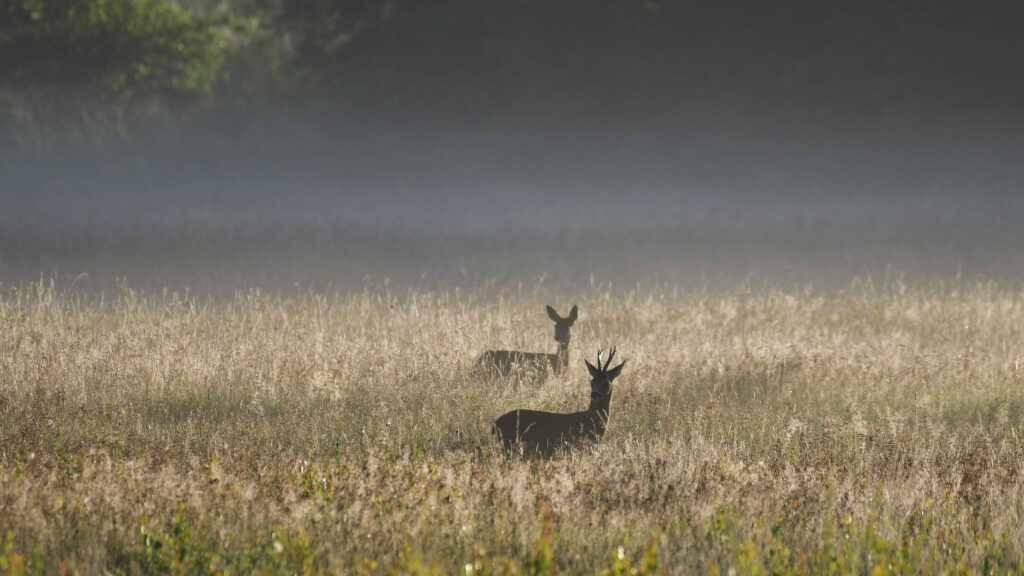

In September 2023, bluetongue virus (BTV, serotype 3) was detected in sheep. Bluetongue is a viral disease that primarily affects sheep and cattle, but other ruminants such as deer can also be infected. The virus is transmitted by infected midges.
Since then, the DWHC has regularly been asked whether roe deer that were in poor condition and/or appeared to be having difficulty breathing could have been infected with bluetongue.

Previous investigations into BTV outbreaks caused by other serotypes have shown that roe deer are not highly susceptible to bluetongue. There was little evidence of clinically observable disease in roe deer due to bluetongue virus, and only low percentages of roe deer with BTV antibodies were found. In Belgium, samples from 796 roe deer from the period 2005-2008 were tested for BTV. No antibodies were found in the 2005 samples; in 2006, 2.75% in 2007, and 1.67% in 2008. Studies in Spain and France also found low percentages of 5.6% and 1.2%, respectively, in roe deer. In the Netherlands, roe deer blood collected in 2009-2010 as part of a separate study was also tested for BTV. No antibodies were found at that time. Because the blood was collected two years after the BTV serotype 8 outbreak in the Netherlands (2006-2008), this does not provide complete information about exposure to the virus during the outbreak itself.
Because we are now dealing with a new serotype 3 in 2023, which may be more pathogenic than serotype 8, it is important to test roe deer for BTV now as well.
In October and November 2023, eight roe deer, six goats, and two bucks, were sent to the DWHC for post-mortem investigation. Four animals were young adults and four were adults. None of the eight roe deer had any abnormalities that could be consistent with bluetongue infection. All eight roe deer were tested for BTV at WBVR in Lelystad, which showed that the animals were not infected with the bluetongue virus. The roe deer were found in the provinces of Limburg (2), North Brabant (3), Overijssel (1), and Utrecht (2).
Of these eight, five animals had pneumonia caused by lungworms, and four of these also had gastrointestinal parasites. One deer had chronic inflammation of the gastrointestinal tract caused by gastrointestinal parasites. Another deer had throat botfly larvae that had caused inflammation of the nasal mucosa. And yet another deer had inflammation in the rumen, possibly caused by rumen acidosis.
For the deer recently examined at the DWHC, BTV was not a problem, but lungworms and other parasites were.
Just as in 2021, it rained frequently and for extended periods. Hypothermia may weaken the deer, making them more susceptible to worm infections.
Information about bluetongue
WBVR: https://www.wur.nl/en/research-results/research-institutes/bioveterinary-research/animal-diseases/virology/bluetongue-1.htm
GD (Dutch): https://www.gddiergezondheid.nl/nl/Diergezondheid/Dierziekten/Bluetongue
NVWA (Dutch): https://www.nvwa.nl/onderwerpen/blauwtong
Sources
Linden, A., Gregoire, F., Nahayo, A., Hanrez, D., Mousset, B., Massart, A. L., De Leeuw, I., Vandemeulebroucke, E., Vandenbussche, F., & De Clercq, K. (2010). Bluetongue virus in wild deer, Belgium, 2005-2008. Emerging infectious diseases, 16(5), 833–836. https://doi.org/10.3201/eid1605.091217
Ruiz-Fons, F., Sánchez-Matamoros, A., Gortázar, C., & Sánchez-Vizcaíno, J. M. (2014). The role of wildlife in bluetongue virus maintenance in Europe: lessons learned after the natural infection in Spain. Virus research, 182, 50–58. https://doi.org/10.1016/j.virusres.2013.12.031
Wijburg, S. R., Fonville, M., de Bruin, A., van Rijn, P. A., Montizaan, M. G. E., van den Broek, J., Sprong, H., & Rijks, J. M. (2022). Prevalence and predictors of vector-borne pathogens in Dutch roe deer. Parasites & vectors, 15(1), 76. https://doi.org/10.1186/s13071-022-05195-w